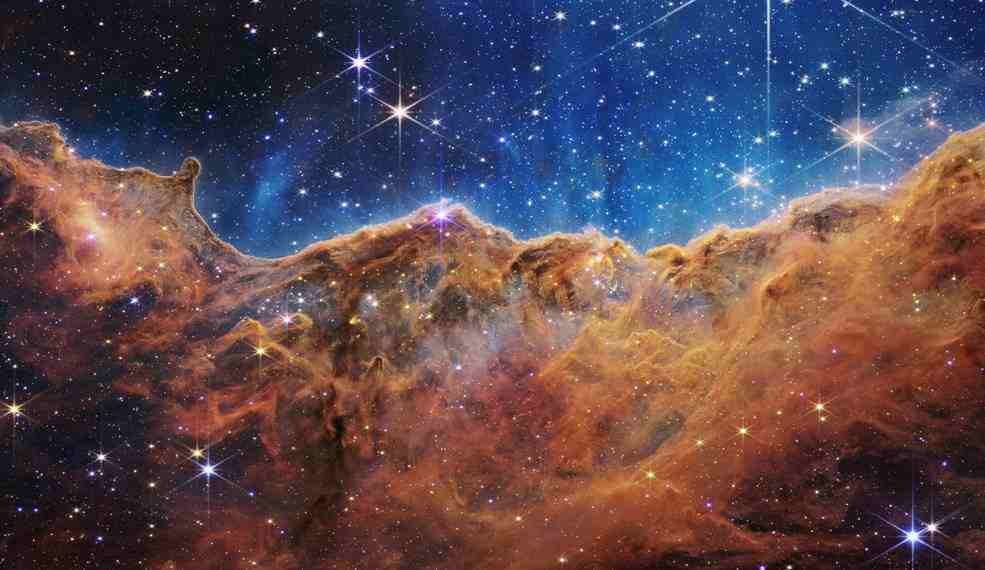Webb Telescope
The James Webb Telescope is the most complex and powerful space observatory ever built. The Webb Telescope is the result of a collaboration between NASA, the European Space Agency and the Canadian Space Agency.
The James Webb Space Telescope (JWST) is in place 1.5 million kilometers (932 056 miles) from Earth. In mid-July 2022, the very first official photos of the observatory were released. The result is fabulous. Hubble’s succession is assured!
The capabilities of the telescope, developed by the US Space Agency with the help of its European and Canadian counterparts, are colossal. Just make a simple comparison between James Webb and Hubble. Or to see how the area photographed by the observatory is only a tiny fraction of the entire Universe. And yet, the details are incredibly precise.
Here is everything you need to know about the very exciting JWST mission, which will be able to provide spectacular observations of space to astronomers around the world.
When did it launch?
It is now done: the James Webb telescope is in space! The launch was successful on December 25, 2021. It then remained to make it fully operational. In total, more than 300 critical points have been identified as potentially problematic during its deployment; obviously, they were closely scrutinized by NASA.
What is the James Webb Telescope used for?
This observatory was designed to advance research in four main areas:
1. Detect the light of the first galaxies, which appeared shortly after the Big Bang.
2. Study the formation and evolution of galaxies.
3. Better understand the birth of stars.
4. As well as exoplanets.
For this, the JWST observes in the infrared range (i.e. the radiation between visible light and microwaves) and in space. Thus, the observatory is able to go far back into the past of the Universe, to see the first galaxies in formation – “baby galaxies” – and to inspect the interior of the clouds of dust in which stars and planets are formed.
What are the instruments of the James Webb Telescope?
The observatory has four scientific instruments on board:
1. A near-infrared camera, the NIRCam (for “Near-InfraRed Camera”), which will among other things detect stars that appeared after the Big Bang, search for supernova, measure distorted light due to dark matter.
2. A near-infrared spectrometer, the NIRSpec (“Near-Infrared Spectrometer”), which makes it possible, for example, to study chemical elements in distant galaxies or clusters of young stars.
3. A mid-infrared instrument, the MIRI (“Mid Infrared Instrument”), with which it is notably possible to observe brown dwarfs, exoplanets and the evolution of stars and protoplanetary systems.
4. A near infrared imager and slitless spectrograph, called NIRISS (“Near Infrared Imager and Slitless Spectrograph”), which helps to study exoplanets and distant galaxies.
Why does the James Webb Telescope have a segmented mirror?
The sumptuous primary mirror of the James Webb telescope, with an estimated diameter of 6.5 meters, does not go unnoticed with its golden coloring and its 18 segments assembled in a hexagonal shape. In astronomy, the mirror is said to be segmented. It is not a technical choice, because it would have been possible to build it in a single block.
It is a logistical motivation behind this choice: it would have been impossible to fit a mirror of this size made of a single block into the rocket that launched the JWST into space. For the first time, it was therefore decided to launch a telescope with a segmented mirror into space.
Will the James Webb Telescope replace Hubble?
It would not be entirely accurate to say that the James Webb Space Telescope is intended to replace Hubble. You have to see him more as a successor. Admittedly, the JWST exceeds a limit of Hubble, which proves unable to see beyond the near infrared (it therefore goes back less far in the past than does the JWST). It is also larger than Hubble in size.
But the day Hubble no longer works, the James Webb Telescope will not have the means to completely replace it. Currently, Hubble is the only telescope capable of observing in the ultraviolet and the JWST is not equipped to do the same.
When was the James Webb Telescope launched?
The James Webb Space Telescope was originally scheduled to launch on December 18, 2021. Eventually, its launch took place on Christmas Day, December 25, 2021.
Where was the James Webb Telescope launched from?
It took off from the Kourou space center in French Guiana, carried on board an Ariane 5 ECA rocket. The observatory had to be transported by boat from California to reach its launch base.
How much does the James Webb telescope cost?
The total cost of the telescope is estimated at US$ 9.7 billion, or € 8.2 billion. Since the beginning of the project, this budget has been regularly revised upwards.
NASA mentions that it participates in the total cost of the JWST to the tune of US$ 7.998 billion. She estimates that the first five years of operation of the observatory, added to the two years necessary to exploit its data, will generate an additional cost of US$ 8.835 billion – knowing that the JWST should certainly double its lifespan.
Why was the launch of the James Webb Telescope postponed?
The flight of the JWST into space has been repeatedly postponed. In 2003, the date envisaged for its departure into space was 2011. Nevertheless, that year, the schedule had to be readjusted due to regular problems and the increase in budget. Representatives of the American Congress have even considered canceling the project, which has become too expensive. However, the launch was pushed back to 2018.
And since then, take-off has been continually postponed. The covid-19 pandemic has further disrupted the pace of work, forcing the launch date into space to be pushed back further to the end of 2021.
Why is the name of the James Webb Telescope controversial?
At the start of the project, the telescope had received the designation temporary “Next Generation Space Telescope” (NGST, for “New Generation Space Telescope”). It was so named to symbolize the continuity of its activities, compared to those of Hubble.
The JWST received its official name on September 10, 2002, referring to James Webb (1906-1992), NASA’s second administrator. He is known for leading Apollo. Nevertheless, this choice of name is questioned by many and many scientists, because James Webb would have favored a policy of exclusion of LGBTQI+ people within the space agency. NASA does not intend to rename it, however.
Who is James Webb?
James Edwin Webb (October 7, 1906 – March 27, 1992) was NASA’s second Administrator, serving from February 14, 1961 to October 7, 1968.
Why should the James Webb Telescope be sent into space?
It was necessary to make the JWST a space telescope, and not a terrestrial one, because this observatory requires very specific observation conditions. The Earth’s atmosphere could blur the images obtained by the telescope, because it is almost opaque and shines in the infrared wavelengths in which the James Webb will observe. The technologies used in terrestrial telescopes do not currently allow this problem to be circumvented.
This need to send it into space makes the mission all the more complex: all the mechanisms of the JWST must work perfectly.
Where is the James Webb Telescope located in space?
It took about a month for the telescope, after its launch, to reach its planned location: the Lagrange point L2, located about 1.5 million kilometers from our planet. It is essential to place the JWST very far away, because it needs a low temperature to function correctly (-223°C or -369°F). Its shield, made up of 5 layers, helps to keep it cold, by blocking the light emitted by the Sun, the Earth and the Moon (it could, by heating the telescope, distort its observations).
But in addition to the shield, the position of the space telescope plays a role: it is placed behind the Earth, in relation to the Sun. The JWST is thus roughly aligned at all times with our planet and the Sun.
At such a distance, no repairs can be envisaged in space, like the maintenance missions that take place with Hubble.
How long should the James Webb Telescope mission last?
From its launch, the telescope was designed for its mission to last at least 5.5 years (including the first six months of its commissioning). The objective would rather be for its lifespan to be greater than 10 years. Unlike the Hubble telescope, it is not so much the operation of its various components that is likely to be problematic over time. Rather, it is the amount of fuel taken on board by the observatory to maintain its orbit that will be decisive. The JWST therefore carries enough fuel to be operational for about ten years.
Sources: PinterPandai, ESA (European Space Agency), BBC, Northrop Grumman
Photo credits: NASA, ESA, CSA and STScI
Photo description: first images from the James Webb Space Telescope.
This landscape of “mountains” and “valleys” speckled with shimmering stars is actually the edge of a nearby young star formation region called NGC 3324 in the Carina Nebula. Captured in infrared light by NASA’s new James Webb Space Telescope, this image reveals for the first time a previously unseen area of stellar birth.
Called the Cosmic Cliff, Webb’s three-dimensional image looks like rugged mountains on a moonlit night. In reality, it is the edge of a giant gas cavity inside NGC 3324, and the highest “peak” in this image is about 7 light-years high. The cave area has been carved out of the nebula by strong ultraviolet radiation and stellar winds from a very massive and hot young star located at the center of the bubble, above the area shown in this image.



